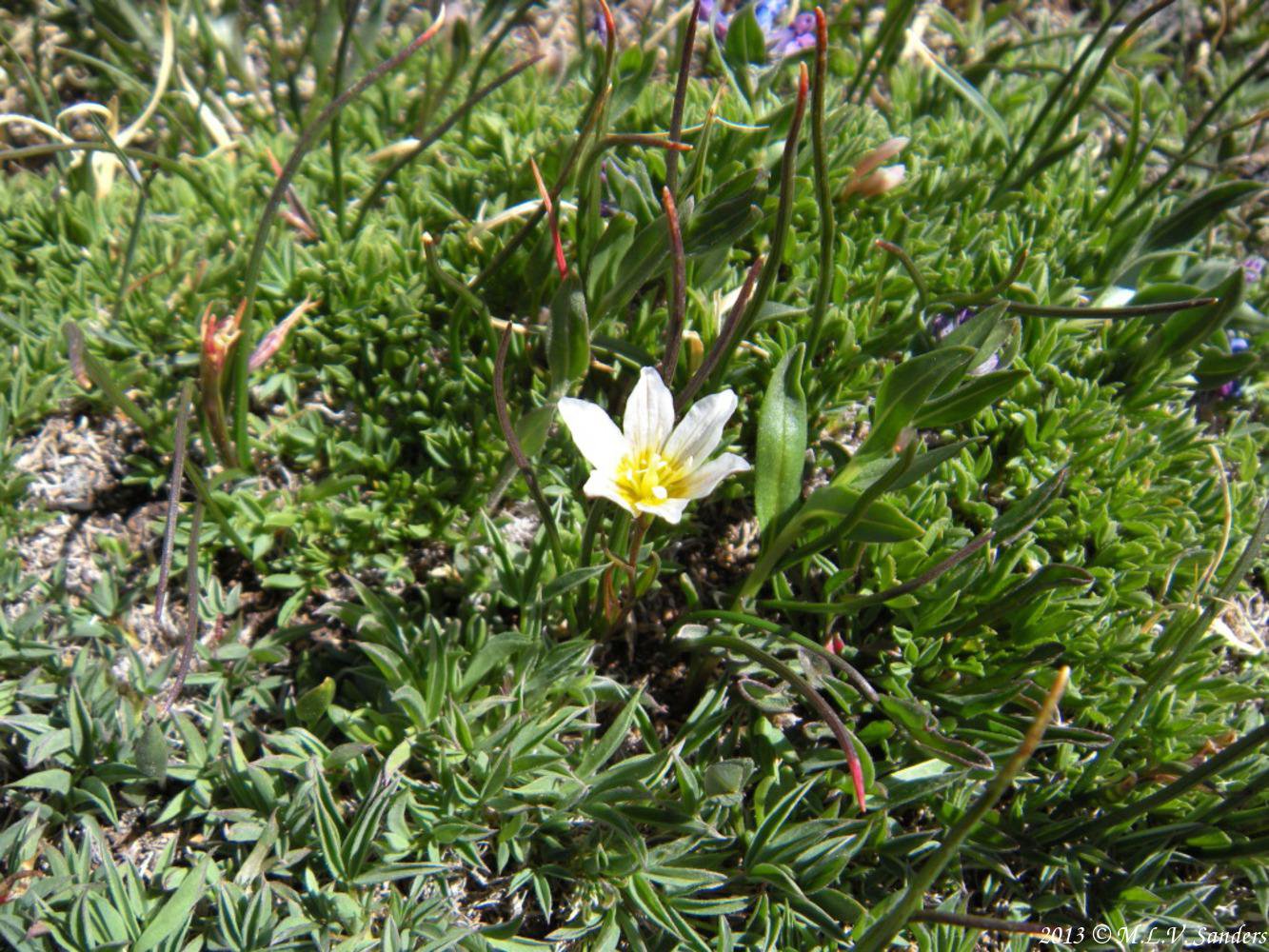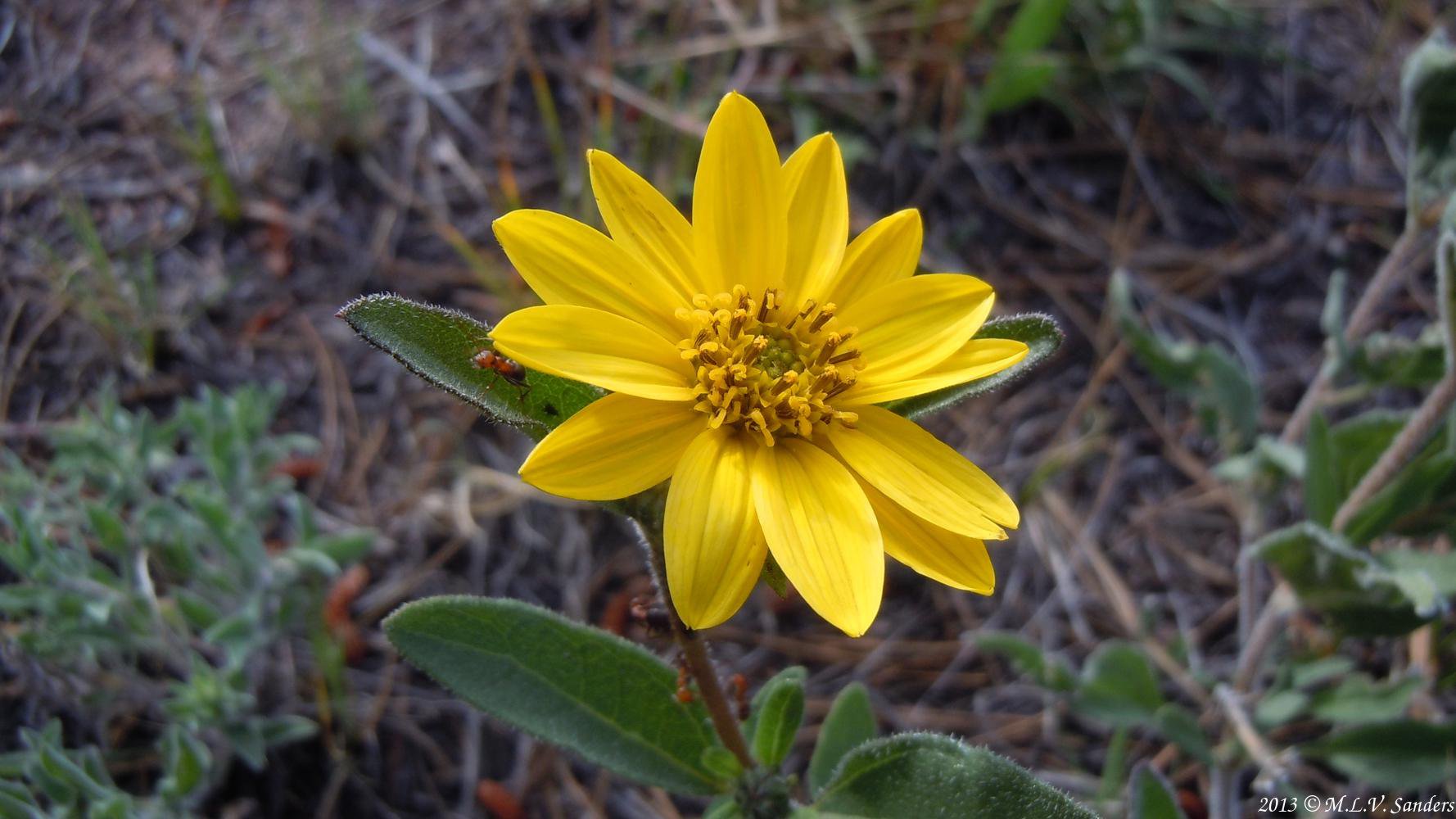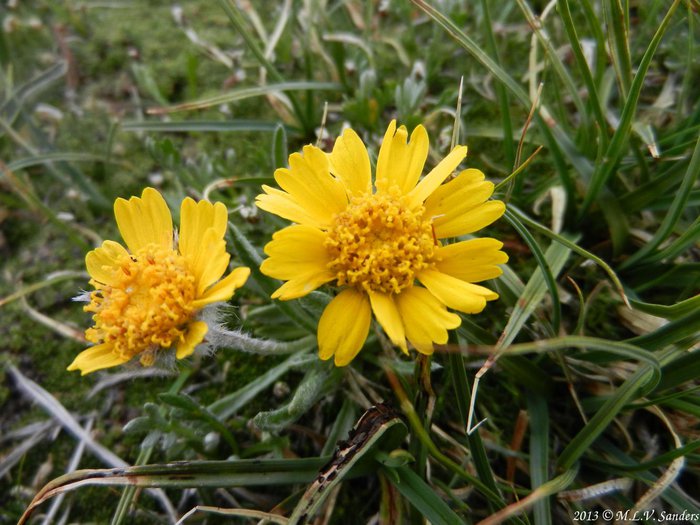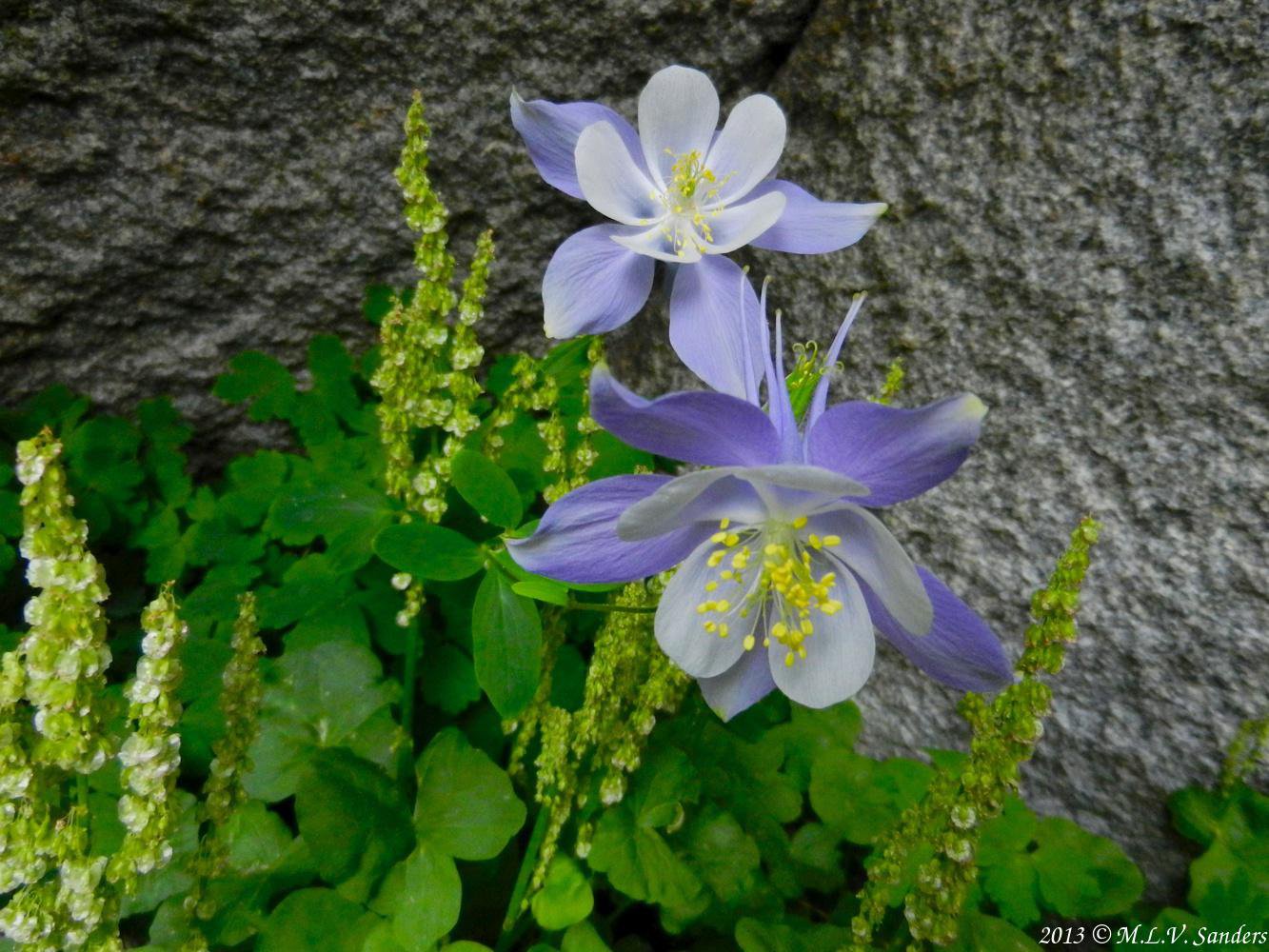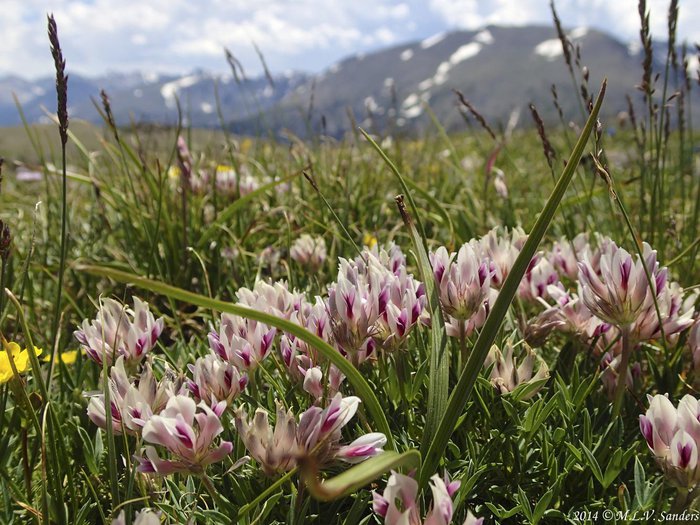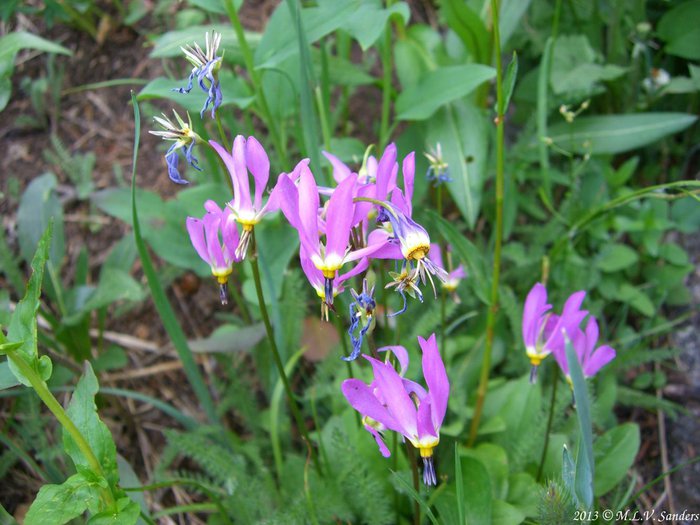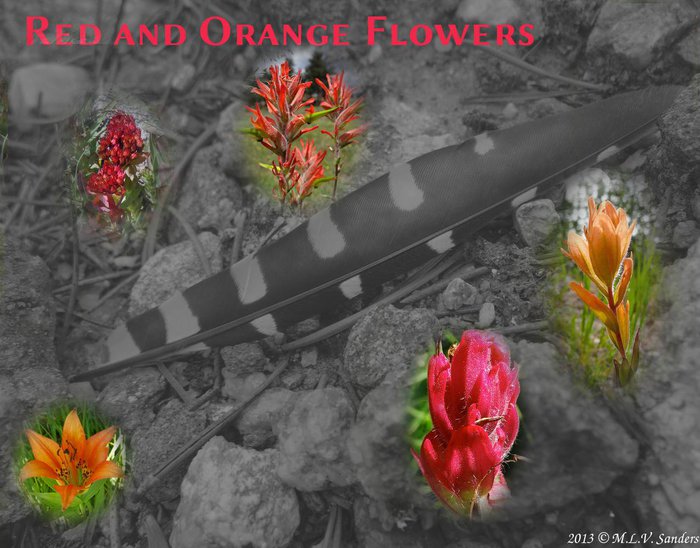Flowers of Rocky Mountain National Park and Indian Peaks
Oct. 31, 2020
revised: April 16, 2021
Welcome! Within, you will find pictures and descriptions of flowers in Rocky Mountain National Park (RMNP) and the Indian Peaks to the south. We do not cover the subject thoroughly. The pictures are of whatever happened to strike our fancy while carrying a camera.
We grouped the flowers by color, an easy and natural approach but not very scientific. Consider some examples. The flower monkshood appears in two places on this page as both a blue and a white flower. We classify the colorado columbine as a blue flower although it has almost as much white as blue color. A flower we call pink, others may call purple.
Disclaimer

![warning sign on high bluff above the Mississippi River at Effigy Mounds National Monument in Iowa]()
![warning sign on high bluff above the Mississippi River at Effigy Mounds National Monument in Iowa]()
Proceed with care as you would here on the edge of a high bluff above the Mississippi River. The picture is of a warning sign at Effigy Mounds National Monument in Iowa.
Warning! Enjoy the pictures if you will, but be cautious about the words you read. We have taken care in the identification of the flowers and plants. Nevertheless, it is easy to error for those, such as us, lacking proper training and study in the complex technical subject of botany.
White Flowers
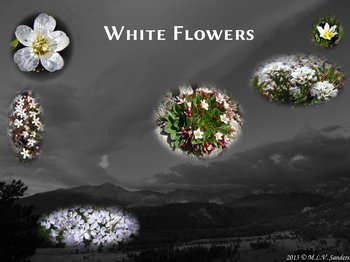
![images of white flowers with background of Rocky Mountain National Park]()
![images of white flowers with background of Rocky Mountain National Park]()
Below are white flowers such as the alpine springbeauty, alplily, and mountain candytuft found in Rocky Mountain National Park and the Indian Peaks.
Alpine Phlox
The alpine phlox _1_ flower color varies from white to light blue. When in bloom, the plants can be covered in almost solid carpets of flowers. The alpine phlox grows primarily in rocky areas in the alpine zone above tree line but sometimes grows below the alpine zone. The alpine phlox is a cushion plant that conserves moisture and avoids high winds by growing as dense compact mats low to the ground.
Alpine phlox grow in the harsh and bleak environments of fellfields in the alpine tundra. Zwinger and Willard in their book about alpine tundra _2_ (p75-80) describe fellfields as wind swept areas in the tundra with little top soil and covered in rocks and gravel. Because of high winds, little snow accumulates in fellfields, which makes them rather dry in the spring and summer.
Nelson _1_ (p218) gives Phlox pulvinata as the scientific name for the alpine phlox. Weber _3_ (p290) provides the scientific name Phlox sibirica subsp pulvinata for plants near the Continental Divide in the northern counties of Colorado.

An alpine phlox with flowers just a few inches from the ground grows next to a rock. These plants often grow in rocky wind swept areas.

A small group of alpine phlox white to light blue flowers.
Alpine Sandwort
The alpine sandwort, Minuartia obtusiloba, is an alpine plant that grows in the Arctic. It forms large very low mats that are somewhat open with very small leaves and scattered flowers - Nelson _1_ (p93).

![alpine sandwort, Minuartia obtusiloba, on the tundra in Rocky Mountain National Park]()
![alpine sandwort, Minuartia obtusiloba, on the tundra in Rocky Mountain National Park]()
Flowers are scattered about on this alpine sandwort. This plant forms a mat, but soil can be seen between tufts of tiny leaves.
Alpine Springbeauty
The alpine springbeauty, Claytonia megarhiza, has thick wide succulent leaves attached at the base, _1_. White to pink or rose flowers with five petals protrude from between the closely packed leaves. This plant often grows in rocky areas such as the top of high mountains. Because of its thick taproot, another common name is Big-rooted Spring Beauty _4_.

White flowers of one of many alpine spring beauties blooming on the otherwise barren top of the 13223 ft high Mount Audubon.

A gnarled and by all appearances, beaten Alpine Spring Beauty on top of Mount Audubon.

A small group of alpine spring beauties clustered together and blooming by the side of the Mount Audubon trail in the Indian Peaks. Notice there is gravel and no soil around the plants, an indication of the effects of wind.

A side view of an alpine spring beauty on the Mount Audubon trail. The bottom leaves lay flat on the ground.

Red leaves on an Alpine Spring Beauty by the Mount Audubon trail.
Alplily
The Alplily, Lloydia serotina, is a dainty plant 6 inches or less tall, with one or occasionally two white flowers with veins that have a purple or green tinge _4_ . The leaves are thin and thread like. It is an alpine plant found in cold exposed locations up to high elevations _1_ .

![white flower of an Alplily mixed in with other tundra plants]()
![white flower of an Alplily mixed in with other tundra plants]()
The white flower of an Alplily mixed in with other tundra plants.
Arctic Gentian
In late summer in the mountains it is sad to see many of the tundra flowers finishing for the season. But the sadness is alleviated by the late summer blooming of the arctic gentian, Gentiana algida _4_ . The flowers of this gentian are striking and stand out on the tundra. Each flower is relatively long and white with blue markings on both the outside and inside.

Looking down on an arctic gentian plant with multiple flowers.

An arctic gentian seen on a stroll at Medicine Bow Overlook on July 31, which on the tundra, is late summer.

Arctic gentian near Tranquil Tarns in the Indian Peaks.

arctic gentian on the Mount Audubon Trail. In the background there appears to be more out-of-focus arctic gentians.

Arctic gentians dot the landscape along the Mount Audubon Trail. In the background, the four mountain peaks are from left to right: Chiefs Head Peak, Pagoda Mountain (shaped like a pyramid), Longs Peak (with a high flat top) and Mount Meeker. If you look close at the largest image on the Arctic Gentian Gallery Page, the two summits of Mount Meeker can be seen.
Dotted Saxifrage
One distintive feature of the dotted saxifrage, Ciliaria austromontana (synonym: Saxifraga bronchialis ssp. austromontana) _5_, is the five white petals of the flower have red dots and orange dots. The red dots are on the outside half and the orange dots are on the inner half or base of the petal.
According to science.halleyhosting.com the color of the dots (or spots) near the base of each petal are yellow or yellow-orange. This website also reports three other common names for this species: matted saxifrage, spotted saxifrage, and yellow-dot saxifrage.
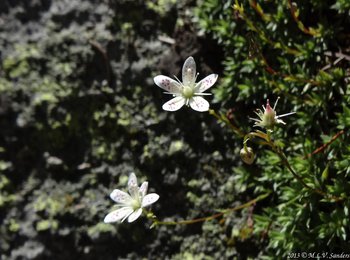
![Two dainty flowers of the dotted saxifrage]()
![Two dainty flowers of the dotted saxifrage]()
Two dainty flowers of the dotted saxifrage.
Fairybells
Fairybells, Prosartes trachycarpa (synonym: Disporum trachcarpum), grow in dense montane forests and have white, with sometimes a tinge of yellow, flowers at the end of the branches _5_. The flower will produce red berries.
The three pictures of this flower below were taken in late May 2013 in the then recent burn scar of the 2012 Fern Lake Fire. The backgrounds of these photographs are bleak. We saw no other living plant in the immediate area of this blooming fairybells plant.

Blooming fairybells with burned trees of the 2012 Fern Lake Fire in the background.

Side view of a fairybells plant with nothing else growing on the burnt forest floor.

Looking up at a Fairybells flower. Burnt tree trunks from the fire soar into the sky.
Field Mouse-ear Chickweed
The field mouse-ear chickweed, Cerastium strictum, is common in the montane zone but is found all the way to the lower alpine zone _5_. The petals of the white flowers have two lobes.

Field mouse-ear chickweed in Rocky Mountain National Park. Each of the five white flower petals two distinct lobes. The middle of the flower is green.

Side view of field mouse-ear chickweed flowers.
Lanceleaf Springbeauty
Beidleman _5_ gives the common name lanceleaf spring beauty for the species with scientific name Claytonia lanceolata. Another common name is western springbeauty. USDA shows a wide range for Claytonia lanceolata throughout Western North America with 7 variations of the species.
The lanceleaf spring beauty has two opposite wide leaves on its stem _5_. It grows in moist ground near melting snowbanks.The flower of the lanceleaf spring beauty (Claytonia lanceolata) is very similar in appearance to the flower of the pink spring beauty (Claytonia rosea). See the pink spring beauty section below for a comparison of the two species.
The ecology of the lanceleaf springbeauty in snowbanks is very interesting . Studies reported by Halleck _6_ show the lanceleaf springbeauty likely begins active growth and reproductive development in January while buried under deep snow banks. In the Colorado Front Range, as the deep snowbanks in spruce-fir forests slowly melt, lanceleaf springbeauties bloom as they become uncovered. The flowering of lanceleaf springbeauties continues into the summer as late as July.

A beautiful lanceleaf springbeauty with the typical pink anthers. The petals are white with yellow at the base, and small notches on the tips. The wide leaves on the stem are poking out from behind the flower.

A small garden of lanceleaf springbeauties. These flowers and the clumps of brown grass at the top of the picture have been recently covered by snow.

Snowbanks found in the area where the previous pictures of lanceleaf springbeauties were taken. The Lanceleaf springbeauty blossoms when uncovered by melting snowbanks.
Monkshood
The unusual white monkshood is a variety of the more common blue or purple monkshood. This small stand of while monkshood flowers was next to the Thunder Lake Trail between the trailhead and the bridge across St Vrain Creek. The white monkshood is the ochroleucum variety of the blue/purple species Aconitum columbianum (Weber p206 _3_). Weber reports that the ochroleucum variety is "greenish white".
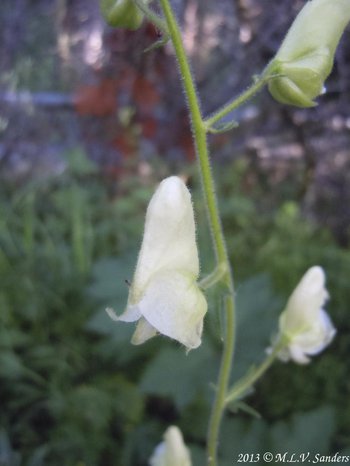
The flower of this white monkshood, does look like a very tall hood.

Entire white monkshood plant.
Mountain Candytuft
The mountain candytuft , Noccaea montana, _5_ is found from the montane zone to the alpine zone and has striking small bouquets of white flowers. This species has an impressive number of synonyms for its scientific name: Thlaspi coloradense, T. montanum, T. alpestre, and T. fendleri _4_. There are at least two additional common names: mountain pennycress and wild candytuft .

![Three mountain candytufts growing side by side, Rocky Mountain National Park, Colorado]()
![Three mountain candytufts growing side by side, Rocky Mountain National Park, Colorado]()
Three mountain candytufts growing side by side. Its a little hard to see everything in the picture, but there are a group of leaves growing close to the ground and additional leaves growing on the stem leading to the cluster of bright white flowers.
Mountain Deathcamas
The Mountain Deathcamas, Anticlea elegans, has white flowers with conspicuous green/yellow glands _5_. It is found from the subalpine to lower alpine zones. As the scientific name suggests, this species is very elegant. But, as the common name suggests, this species is also very poisonous. The scientific name used to be Zygadenus elegans.

The greenish glands are at the base of each white petal of the mountain deathcamas are very distinctive.
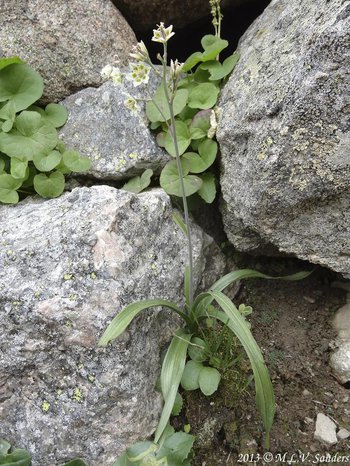
Notice the leaves with parallel veins at the base of the mountain deathcamas.

Closeup of mountain deathcamas flower.
Northern Bedstraw
Northern bedstraw, Galium septentrionale, grows in montane and subalpine forest openings _5_. It has a tall stem with numerous clusters of white flowers. Some references use the scientific name Galium boreale _1_. See swcoloradowildflowers.com for a discussion of the two scientific names.

Northern Bedstraw plant on the Thunder Lake Trail. Closeup showing flowers.

Overview of Northern Bedstraw on Thunder Lake Trail. Notice that the long skinny leaves are attached in groups of four along the upright stem.
Paintbrush That Appears White
To a non technical person interested in flowers, it is easy to learn to identify a paintbrush (Castilleja genus) plant. A non technical person can often just glance at a paintbrush plant and and correctly identify it as a paintbrush. However it is much more difficult to correctly identify the species of a paintbrush.
The paintbrush in the pictures in the gallery below appears to be a white color with a yellowish tint. The primary reason for taking these pictures was the unusual color. This plant was growing in the subalpine zone by the side of the trail between Mills Lake and Black Lake. There was a very small waterfall nearby and the soil was somewhat moist.
This plant below could be a northern paintbrush, Castilleja sulphurea (synonym: C. septentrionalis) _5_ which is yellow. However the northern paintbrush often hybridizes with the rosy paintbrush, C. rhexifolia. The resulting hybrid can be white or various shades of yellow. So perhaps this plant is a hybrid? Then again, perhaps it is some other species?

White paintbrushes (with a few yellowish ones), possible hybrids, by trail to Black Lake. Some of these paint brushes are rather tall.

Pretty by any name, an almost white paintbrush with some yellowish tint.
Pasque Flower
The pasque flower, Pulsatilla patens ssp. multifida, blooms early in the spring _1_. It grows primarily in the foothills and the montane zone but is found up to tree line. The flower color usually ranges from blue to lavender but is sometimes white or whitish. It only grows east of the Continental Divide.

A pasque flower with a beautiful lavender color. This flower is growing in a montane open meadow near scattered ponderosa pine trees.

This pasque flower has white petals with a slight lavender hue and a golden middle.

The white petals of the inside of this pasque flower have a bluish hue on the tips and edges. There are fine hairs on the stems.

A view from the side of a pasque flower in late May shows lavender veins in the flower that are highlighted by sunlight. The sun also highlights numerous fine hairs on the stem.
Pearly Everlasting
The white flowers of the pearly everlasting, Anaphalis margaritacea, are common in the subalpine zone _5_.

![pearly everlasting on the Bluebird Lake Trail, Rocky Mountain National Park, Colorado]()
![pearly everlasting on the Bluebird Lake Trail, Rocky Mountain National Park, Colorado]()
A field of pearly everlasting on the Bluebird Lake Trail on the moraine overlooking Ouzel Creek. These flowers were numerous on this moraine among the charred fallen trees from the 1978 Ouzel Fire.
Pink Springbeauty
The pink springbeauty with scientific name Claytonia rosea _5_ is similar to the lanceleaf springbeauty. It usually has leaves around the base of the plant when flowering and a pair of opposite leaves on the stem. The pink springbeauty grows in the montane zone of Rocky National Park in the early spring.
A map in the USDA website shows the C. rosea species ranging from Arizona and New Mexico to Montana. However sometimes flower references lump this species in with the very similar C. lanceolata (lanceleaf springbeauty) _5_.

Pink springbeauty plant with two flowers near Cub Lake. The stem leaves are narrow and the tips of the leaves come to a point. But, there are no visible leaves that are typically at the base of the plant.

Pink Springbeauty with blooming flower and multiple buds, also near Cub Lake.

Two pink springbeauties in the spring of 2013 near Cub Lake. In the background is the charred remains of brush burned in the 2012 Fern Lake Fire.

Pink springbeauty on the Fern Lake Trail. This blossom has noticeable purple highlighting the veins on its petals.
Comparison Between Claytonia rosea (Pink Springbeauty) and C. lanceolata (Lanceleaf Springbeauty)
The following two lists are criteria from Halleck's paper _6_ that distinguish the two very similar species Claytonia rosea and C. lanceolata. Bear in mind that C. lanceolata is a wide spread and highly variable species and the observations below for it are primarily for the Colorado Front Range.
C. rosea (Pink Springbeauty):
- basal leaves (leaves at the very bottom of the plant): typically two, varies from 0-10
- cauline leaves (leaves part way up the stem): two opposite leaves that are linear to linear-lancelot (the leaves are relatively narrow)
- petal apices: usually acute (petal tips have a sharp or well defined point)
- ecology: grows in montane zone. Flowers bloom after (usually several weeks after) the snow cover has melted.
C. lanceolata (Lanceleaf Springbeauty):
- basal leaves (leaves at the very bottom of the plant): none
- cauline leaves (leaves part way up the stem): two opposite leaves that are ellipitcal-lancelot to ovate (the leaves are relatively wide)
- petal apices: emarginate (a shallow notch at the tip of the petals)
- ecology: grows in conjunction with melting snowbanks around spruce-fir forests in the subalpine zone.
Snowball Saxifrage
The snowball saxifrage, Micranthes rhomboidea (synonym: Saxifraga rhomboidea), grows at all elevations _5_ in Rocky Mountain National Park. The snowball refers to a spherical display of white flowers at the top of the single stem. This plant is also called the diamond leafed saxifrage because of the shape of its toothed leaves that grow at the bottom of the plant _4_.

![snowball saxifrange with flowers that are not fully open. Rocky Mountain National Park]()
![snowball saxifrange with flowers that are not fully open. Rocky Mountain National Park]()
The white flowers on these snowball saxifrages are not fully open. When fully open, the red between the individual flowers is not so visible. Each snowball saxifrage has a single stem _4_, so there are two snowball saxifrage plants in this picture.
Yellow Flowers

![images of yellow flowers with background of Rocky Mountain National Park]()
![images of yellow flowers with background of Rocky Mountain National Park]()
Below are some of the yellow flowers found in the Colorado front range area which encompasses Rocky Mountain National Park and the Indian Peaks.
Alpine Avens
The alpine avens, Acomastylis rossii ssp turbinata, is very common in the alpine zone and also grows in the subalpine _5_. The foliage turns red in the fall, often dominating the color of the fall tundra.

![Blooming alpine avens after a summer hail storm]()
![Blooming alpine avens after a summer hail storm]()
Blooming alpine avens after a summer hail storm.
Bush Sunflower
The bush sunflower, Helianthus pumilus, grows in the montane _5_ and foothills _3_. The leaves are usually opposite, the stem is hairy and the plants are rather short for a sunflower. Sometimes it is called dwarf sunflower. The bush sunflower is said to be endemic, meaning the plant is only found in a particular area or place. The blog A Wandering Botanist describes the remarkably specific area in which the bush sunflower will only be found.
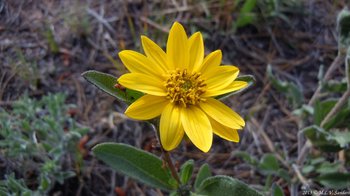
![flower of a bush sunflower, Helianthus pumilus, growing in a dry montane area on the grounds of the YMCA of the Rockies]()
![flower of a bush sunflower, Helianthus pumilus, growing in a dry montane area on the grounds of the YMCA of the Rockies]()
The flower of a bush sunflower growing in a dry montane area on the grounds of the YMCA of the Rockies.
Creeping Hollygrape
The creeping hollygrape is a creeping evergreen with bundles of yellow flowers that grows in montane forests. The scientific name is Mahonia repens (synonym: Berberis repens) _5_. The blog A Wandering Botanist provides a lengthly discussion of this plant, and pictures that include shots of the berries and winter foliage.
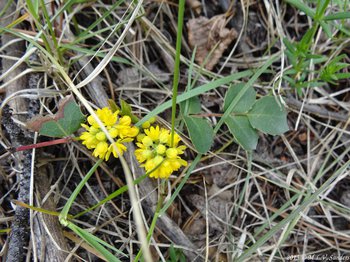
Creeping hollygrape growing on the forest floor in the montane zone of Rocky Mountain National Park.

Closeup of two round balls of flowers on a creeping hollygrape

Below the yellow flowers of the creeping hollygrape is a leaf of the plant, which appears similar to the leaf of a holly plant.
Golden Banner
The golden banner, scientific name: Thermopsis divaricarpa, grows mostly in the montane zone West of the Continental Divide, but is found at other elevations as well. The golden banner blossoms in late spring and early summer. A different but similar related species grows only on the Eastern slopes of the Continental Divide and the two species can only be distinguished by location and seed pods _1_.

![Golden Banner next to the road to the Fern Lake Trailhead in Rocky Mountain National Park]()
![Golden Banner next to the road to the Fern Lake Trailhead in Rocky Mountain National Park]()
Golden Banner next to the road to the Fern Lake Trailhead in Rocky Mountain National Park.
Goldenrod
Goldenrod is a genus (scientific name: Solidago) with nine different species found in Rocky Mountain National Park _5_. Due to the large number of species it is challenging for an amateur to make a reliable identification. Goldenrods are in the sunflower or Asteraceae family and the flowers have small heads with small rays.

A goldenrod plant in Rocky Mountain National Park with relatively thin leaves which is typical of the genus.

Closeup of the many flowers on a goldenrod plant. Each flower is like a small sunflower and not very prominent by itself. But the large number of flowers gives an overall striking appearance to the plant.

Flowers distributed along the length of the stalk of a goldenrod plant.

These flowers were found on a plant growing low to the ground at Forest Canyon Pass, almost in the tundra. The flowers look as though the plant might be a goldenrod.
Old Man of the Mountain
The old-man-of-the-mountain, also called the alpine sunflower, grows on the tundra. The plant has a large yellow flower, which usually faces East _5_ and is very prominent on the tundra. This is one of our favorite tundra plants. The scientific name is Rydbergia grandiflora (synonym: Hymenoxys grandiflora).

Tattered petals of an old man of the mountain in the tundra of Rocky Mountain National Park.

The flower of an old man of the mountain facing East.
Western Wallflower
The Western Wallflower, Erysimum capitatun, is a member of the brassicaceae (mustard) family and is found at all elevations in Rocky Mountain National Park. The flowers color of its four petals ranges from yellow to orange _5_. This a very diverse species that lives in different ecological zones and some botanists (but not all) _7_ divide the species into varieties.
The alpine variation used to be identified as a different species, Alpine Wallflower, E Nivale, that grew predominantly in the alpine zone _1_. The plants in the alpine zone tend to be very short with flowers grouped in a tuft at the top.

Alpine version of the western wallflower growing on the tundra. It is short, low to the ground, with flowers in a tight bundle or tuft.

An orange western wallflower near Lily Lake in Rocky Mountain National Park.
Woolly Actinella
The wooly actinella or woolly sunflower, has scientific name Tetraneuris brevifolia with synonym Hymenoxys acaulis var. caespitosa and grows in the tundra _5_. Each petal of these distinctive sunflowers has three teeth on the outer edge.

![wooly actinella, Tetraneuris brevfolia, on tundra of Rocky Mountain National Park]()
![wooly actinella, Tetraneuris brevfolia, on tundra of Rocky Mountain National Park]()
Two flowers of wooly actinella, growing on the tundra of Rocky Mountain National Park.
Yellow Stonecrop
The yellow stonecrop is a succulent that grows from the foot hills to the alpine zones _5_, often found on dry, rocky ground. The scientific name is Amerosedum lanceolatum (synonym: Sedum lanceolatum). The yellow star shaped stonecrop flowers in June at lower elevations and later at higher elevations.

Yellow Stonecrop, a common plant in rocky areas.

The succulent yellow stonecrop without its flowers in late May in the montane zone. A most strange unworldly looking plant.
Blue and Purple Flowers

![images of blue and purple flowers with background of Rocky Mountain National Park]()
![images of blue and purple flowers with background of Rocky Mountain National Park]()
The beautiful Colorado columbine and the striking purple fringe are two of the blue and purple flowers found in rocky Mountain National Park and the Indian Peak.
Alpine Kittentails
The alpine kittentails, Besseya alpina, have blueish-purple flowers that look like spikes and grows amongst rocks in the alpine zone _5_. The foliage is woolly.
" ...an alpine kittentail is in flower, fuzzed with a fringe of protruding stamens; a newly emerging plant looks like a lavender pinecone." - Zwinger _2_ p 131.

Two purple spikes of alpine kittentails on the tundra with distant mountains along the horizon.

A closer view of alpine kittentails. The wooly hairs along the stem can be seen.
Colorado Columbine
The Colorado state flower, colorado columbine, grows in the foothills on up to the alpine zone _3_. It is commonly found in aspen groves at lower elevations and in rocky areas at higher elevations. The scientific name is Aquilegia coerulea _3_; although the very similar name Aquilegia caerulea is sometimes used.

![white and blue flowers of the colorado columbine, growing next to a boulder]()
![white and blue flowers of the colorado columbine, growing next to a boulder]()
The white and blue flowers of the colorado columbine, growing next to a boulder.
Larkspur
Larkspur is a common name for the Delphinium genus. According to Beidleman _5_, there are four species of larkspurs in Rocky Mountain National Park, ranging in color from whitish to blue or purple. One characteristic of larkspurs is they have five sepals which are very prominent, not green, and look like beautiful flower petals. In many other types of flowers in other genera, the sepals are green, inconspicuous, and outside or below the real petals.

A worn, tattered, but beautiful flower of a larkspur.

Larkspur plant with one blooming flower and multiple buds.
Mertensia
Beidleman _5_ lists two species of the genus Mertensia in Rocky Mountain National Park, the lanceleaf chiming-bells (Mertensia lanceolata) and the tall chiming-bells (Mertensia ciliata). Both species have clumps of blue flowers; the individual flowers are shaped like bells.
The lanceleaf chiming-bells (Mertensia lanceolata) is found at all elevations but tends to be shorter in the alpine zone. According to Weber _3_ it is :
"A variable and complex species, separable into alpine and lowland, pubescent and glabrous, broad- and narrow-leaved races, all evidently merging and recombining in puzzling ways."
The tall chiming-bells (Mertensia ciliata) grows along streams in the subalpine and lower alpine zones.

![On Trail Ridge Road a flowers of the genus Mertensia are covered in dew drops]()
![On Trail Ridge Road a flowers of the genus Mertensia are covered in dew drops]()
By the side of Trail Ridge Road, flowers of the genus Mertensia are covered in dew drops. The species could be either lanceleaf chiming-bells or tall chiming-bells.
Parry Gentian
The blue and purple parry gentians grow in the forest and meadows of the montane and subalpine zones. They are members of the gentian family and have scientific name Pneumonanthe parryi _3_. The flowers appear at first glance to be cylindrical but are actually barrel shaped, bulging in the middle.

A view looking down into the center of a beautiful blue parry gentian on the trail to Spruce Lake.

A side view of a parry gentian on the trail to Spruce Lake. Notice how the flower bulges out in its middle like a barrel.

On the trail to Crater Lake, a close-up of a parry gentian showing the dotted and lined whitish-greenish interior.

Bright sunlight highlights the leaves of a parry gentian plant at Forest Canyon Pass.
Purple Fringe
The numerous purple flowers of the purple fringe, Phacelia sericea, form spike shaped clusters centered around vertical stems of the plant _1_. From this spike of purple flowers, long thin purple stamens with yellow tips stick out well beyond the flower petals and surround the flower cluster with yellow dots which appear to float in the air. This species occurs in the subalpine often in disturbed areas such as road sides _5_.

Two purple flower spikes of the purple fringe surrounded by yellow dots which are the yellow tipped stamens of the flowers.

Two blooming purple fringe plants side by side in front of a boulder.
Sky Pilot
When walking on the tundra, it is a pleasure to see sky pilots, Polemonium viscosum, with their tight clusters of beautiful purplish flowers _1_. Inside each flower are distinct and visible orange anthers.
Sky pilots tend to grow in disturbed areas of the tundra. Zwinger and Willard in their book about the tundra _2_ (p198-202) describe how pocket gophers dig shallow tunnels that cause wind and water erosion on the tundra. Sky pilots and other short-lived plants invade into and thrive in this newly altered landscape called "gopher gardens" by the authors .
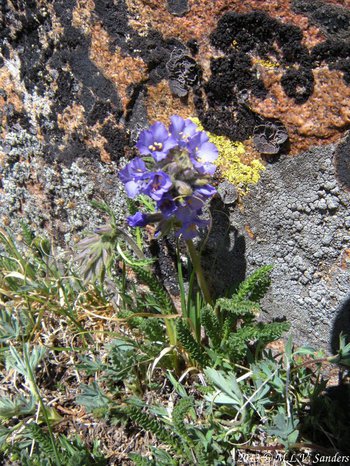
A sky pilot growing next to a large lichen-covered boulder.

A purple flowered sky pilot growing next to some yellow alpine avens on the tundra.
Star Gentian
The flower color of the star gentian, Swertia perennis, varies from dark blue to purple _5_. The flowers are star shaped with five, sometimes four, petals. The star gentian grows from the montane to the alpine zones, but is most commonly found in moist areas of the subalpine.

Two star gentian flowers growing in a moist area on the trail to Black Lake.

When viewed at a distance, star gentian flowers appear light blue or purple. But in a close-up view, blue or purple irregular stripes cover the flower petal's white background.

Star gentian flowers and buds that were seen on a hike to Fern and Odessa Lakes.
Pink Flowers

![pink flowers]()
![pink flowers]()
There are numerous pink flowers in the region including the rose crown, shooting star, fairy slipper and the pink pyrola.
Alpine Primrose
The alpine primrose, Primula angustifolia, blooms early in snow free areas of the tundra_5_. Another common name for this beautiful plant is fairy primrose_1_.

The five pink petals, with a yellow eye in the middle, indicates an alpine primrose on the tundra. Notice the funnel shape of the narrow leaves which helps bring water to the roots.

Alpine primrose mixed in with other plants on the tundra.
Clover
Clover is a genus with scientific name Trifolium. They typically have spherical flowers with three leaflets each. The genus is fairly easy to identify, but the individual species are much harder. There are eight species_5_ of clovers in Rocky Mountain National Park

![alpine clovers growing on Trail Ridge with the distant Stones Peak in the background]()
![alpine clovers growing on Trail Ridge with the distant Stones Peak in the background]()
We suspect these are alpine clovers, but are not entirely certain of the species. Patches of clover on the tundra add sweet fragrance to beautiful mountain views. The large distant mountain on the right is Stones Peak. We took this photograph a distance away from the tiny parking area where the Ute Trail crosses Trail Ridge Road.
Elephantella
Elephantella (Pedicurlaris groenlandica) are very abundant in subalpine wet areas. Their range extends lower into the montane and higher into the alpine. The species often grows in marshes, and along the edges of streams and ponds _1_. Another common name is elephanthead which accurately describes the remarkable shape of the flowers. Numerous flowers, looking like miniature pink elephant heads, attach to the upper portion of the main vertical plant stem. These mock elephants look outward in all different directions from the stem. We call the flower color, "pink", without hesitation. However, Nelson _1_ refers to the flower color as purple or rose.

An elephantella growing in a wet grassy area. The lower flowers on the main stem have finished blooming.

Elephantella blooming well above tree line by the trail to Mount Audubon in mid August. Moisture for the water loving elephantella was provided from nearby melting snow drifts that still remained in late summer.
Fairy Slipper
The orchid fairy slipper, Calypso bulbosa variety americana, grows mostly in cool, moist, pine and aspen, forests in the montane and lower subalpine _5_ _8_. This orchid has a pleasing fragrance and provides stunning beauty with vivid colors. An oddity of fairy slippers is the flowers have no nectar. That means fairy slippers attract and are pollinated by bees, but the bees receive no benefit for their service and are cheated.

Blooming fairy slippers growing in one their favored habitats, underneath pine trees, as evidenced by the pine needles on the ground. Each of the solitary orchid flowers is at the top end of a bare stalk with a single lone leaf near the bottom end.

A large group of fairy slippers growing together.
Fireweed
The genus fireweed, scientific name: Chamerion, has two species that grow in Rocky Mountain National Park (RMNP)_5_. The two species look somewhat similar to each other, at least to the untrained eye.
The species: common fireweed, C. danielsii, grows in the montane and subalpine of RMNP. This species has multiple scientific names which causes confusion.
The common fireweed aggressively moves into disturbed areas, most notably forested areas that have been burned. The USDA Fire Effects Information System web page describes how fireweed invades burned areas. Just after a fire, wind-dispersed fireweed seeds enter the burned area and start growing. The fireweed plants can then rapidly spread through underground rhizomes and form large colonies.
The broadleaf fireweed, C. subdentatum, grows in the subalpine and alpine. This species is, in general, common through the mountainous Northwest, but not very common in RMNP.

A blooming fireweed growing on an unnamed 11961 ft point overlooking Forest Canyon Pass. This is one of a number of fireweeds tucked in amongst big boulders in the sun and out of the wind. Fireweed is not usually found at such a high elevation on the tundra. This is most likely a broadleaf fireweed.
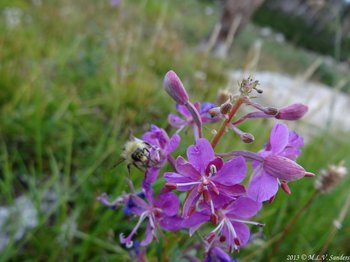
Fireweed with a bumble bee.

Pink flowers of a fireweed growing where the Bluebird Lake Trail passes through the burn scar of the 1978 Ouzel Fire.
Kansas Gayfeather
The kansas gayfeather or Liatris punctata grows from the plains to the lower montane _1_ East of the continental divide mostly in dry areas.
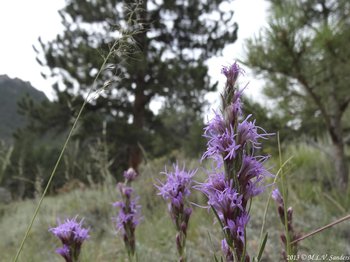
On the grounds of the YMCA of the Rockies, kansas gayfeathers are blooming in a fairly dry area of the montane zone.

Closeup of kansas gayfeather flowers.

A kansas gayfeather with small green insect in one of the blossoms.
Mountain Ball Cactus
The mountain ball cactus, Pediocactus simpsonii var. minor, ranges from foothill canyons _3_ to the montane up to 10000 ft elevation_1_. It blooms mid-April to late May. As it is a cactus, it is unsurprising that the mountain ball cactus grows in sunny, rocky, and dry areas.

Two mountain ball cacti growing in a meadow with a few trees in the background. The plant is spherical but somewhat flattened. The dazzling flowers emerge from the top of the cactus ball.

Pink flowers of the mountain ball cactus with yellow pollen scattered about on the petals.

A view looking down on three of the large flowers of a mountain ball cactus which hide most of the cactus ball below.

A very large Mountain Ball Cactus blooming in upper Beaver Meadows close to the paved road.

Along one side of the Cub Lake Trail a hiker can see a dry area with this mountain ball cactus. The same hiker by merely turning their head would see a vastly different ecological zone with a stream, ponds and lush wet meadows.

A blooming mountain ball cactus growing by a boulder with snow covered Longs Peak and the front range in the distant background.
Pink Pyrola
In the wet areas of subalpine spruce-fir forests _5_ grows the pink pyrola, Pyrola rotundifolia ssp. asarifolia, also called bog pyrola.

Flowers cling to the lone vertical stem of a pink pyrola growing in a lush area of Rocky Mountain National Park.
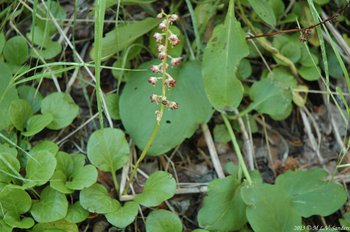
Pink pyrola with finished dried flowers is on the forest floor. Notice the round leaves at the bottom of the plant.
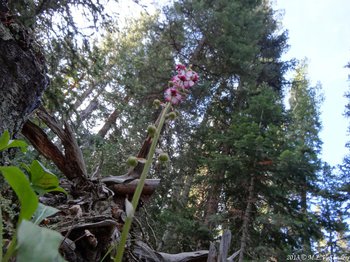
This unusual view is looking up at the flowers of the pink pyrola. The white color on the flower petals can be seen from this angle.
Pipsissewa
Pipsissewa, Chimaphila umbellata ssp. occidentalis, grows in forests of the upper montane zone,

A single flower with some buds, of a pipsissewa growing by the trail between Fern Lake and Spruce Lake.

More pipsissewa we saw on the way to Spruce Lake.

Still more pipsissewa growing in a coniferous forest on the route to Spruce Lake.
Rose Crown
The rose crown grows in wet areas of the subalpine and alpine_5_. We have always used the name "queens crown" for this flowering sedum but the guide books we have prefer the name "rose crown" . The scientific name is Clementsia rhodantha with synonyms Sedum rhodanthum and Rhodiola rhodantha. The rounded, cone shaped flowers have a pink color.

Blooming rose crowns mixed in with other plants.

A close view looking down on the flower of the rose crown.
Twinflower
The twinflower, Linnaea borealis, grows in shady, slightly wet ground in the upper montane and subalpine_1_. In agreement with the name, two light pink flowers attach to the top of thin stems rising from leaves near the ground.

Two faintly pink, funnel shaped flowers of the twinflower. The flowers are symmetric about their stem.

A group of twinflowers growing by the Thunder Lake Trail. These plants may be connected together by woody trailing vines underneath the leaves and debris on the forest floor.
Wax Currant
The wax currant, Ribes cereum, is a flowering bush that grows in the montane_5_. In this region the wax currant grows to 3 feet high and its flowers tend to be pink. Later in the summer the wax currant bushes are covered with reddish berries. Weber_3_, who takes great care to be precise, reports of the wax currant: "The berries make a very fine, resinous, homemade wine".

A wax currant blooming in late May in Beaver Meadows.

This closeup view on end of the wax currant flowers shows five petals and the tubular shape of the flowers is not apparent.

A sideways view of wax currant flowers shows their long tubular shape.
Western Shooting Star
Along streams and in wet meadows of the montane and subalpine _1_ are found the pink and very distinctive flowered western shooting stars, Dodecatheon pulchellum. The flower petals are turned back and the flower shape appears aerodynamic as though made to zoom through the air — like a shooting star.
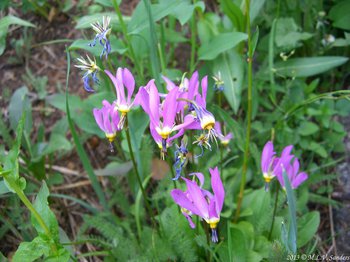
![The pretty and unusual flowers of the western shooting star easily catches the eye of those that walk by]()
![The pretty and unusual flowers of the western shooting star easily catches the eye of those that walk by]()
The pretty and unusual flowers of the western shooting star easily catches the eye of those that walk by.
Wild Rose
The wild rose, rosa woodsii, is found in montane and subalpine forests.

![Near Ouzel Lake grows this wild rose bush with prickly branches.]()
![Near Ouzel Lake grows this wild rose bush with prickly branches.]()
Near Ouzel Lake grows this wild rose bush with prickly branches.
Red and Orange Flowers

![Red and orange flowers in Rocky Mountain National Park]()
![Red and orange flowers in Rocky Mountain National Park]()
In this section, see different species of red and orange flowers such as the Wood Lilly, Indian Paintbrush and Kings Crown.
Kings Crown
In wet and rocky areas of the subalpine and alpine grows the kings crown, Rhodiola integrifolia _4_ _5_.

Three blooming kings crowns standing out in front of a thick growth of green and red tundra plants.

A kings crown flourishing in front of an orange lichen covered rock. Another beautiful tundra plant, the rose drown, grows in the same areas as the kings crow and the two plants loo similar. The kings crown flower is a darker red and the top of the flower tends to be more flat.
Mountain Woodlily
The rare and showy mountain woodlily, Lilium philadelphicum, grows in montane meadows and wet areas near willows _5_. These beautiful flowers should not be picked.

![A mountain woodlily growing in Rocky Mountain National Park. This plant typically has one to three orange or red flowers.]()
![A mountain woodlily growing in Rocky Mountain National Park. This plant typically has one to three orange or red flowers.]()
A mountain woodlily growing in Rocky Mountain National Park. This plant typically has one to three orange-red flowers.
Paintbrush
The genus paintbrush, Castilleja, has nine species that grow in Rocky Mountain National Park_5_. They can be difficult to identify. Paintbrushes are in part parasitic and will feed off of roots of other plants.
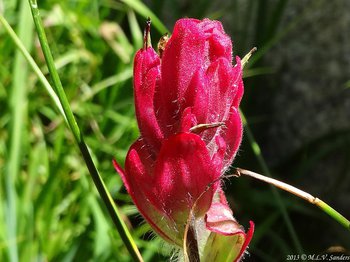
A red paint brush we found on the perimeter of Crater Lake.

This is an unusual orange colored paint brush.

Two paintbrushes growing in the tundra at Forest Canyon Pass.
Brown Flowers
In Rocky Mountain National Park, the species pinedrops appears in the late summer to have brown flowers.
Pinedrops
Pinedrops, Pterospora andromedea, is a very unusual flowering plant_1_ found growing in dry forests often under lodgepole pine trees. A pinedrop plant feeds on the roots of conifers and its leaves lack chlorophyll_3_. The flowers, when they appear are whitish. The flowers turn into brown seedpods that stay on the plant for a long time, even into winter.

![Pinedrops]()
![Pinedrops]()
An attentive hiker walking through a dry forest in late summer will see, from time to time, under the green trees, the tall brown stalks of pinedrops covered with brown seed capsules.
























